coolant level DODGE CHALLENGER SRT 2014 3.G Owners Manual
[x] Cancel search | Manufacturer: DODGE, Model Year: 2014, Model line: CHALLENGER SRT, Model: DODGE CHALLENGER SRT 2014 3.GPages: 529, PDF Size: 3.28 MB
Page 441 of 529
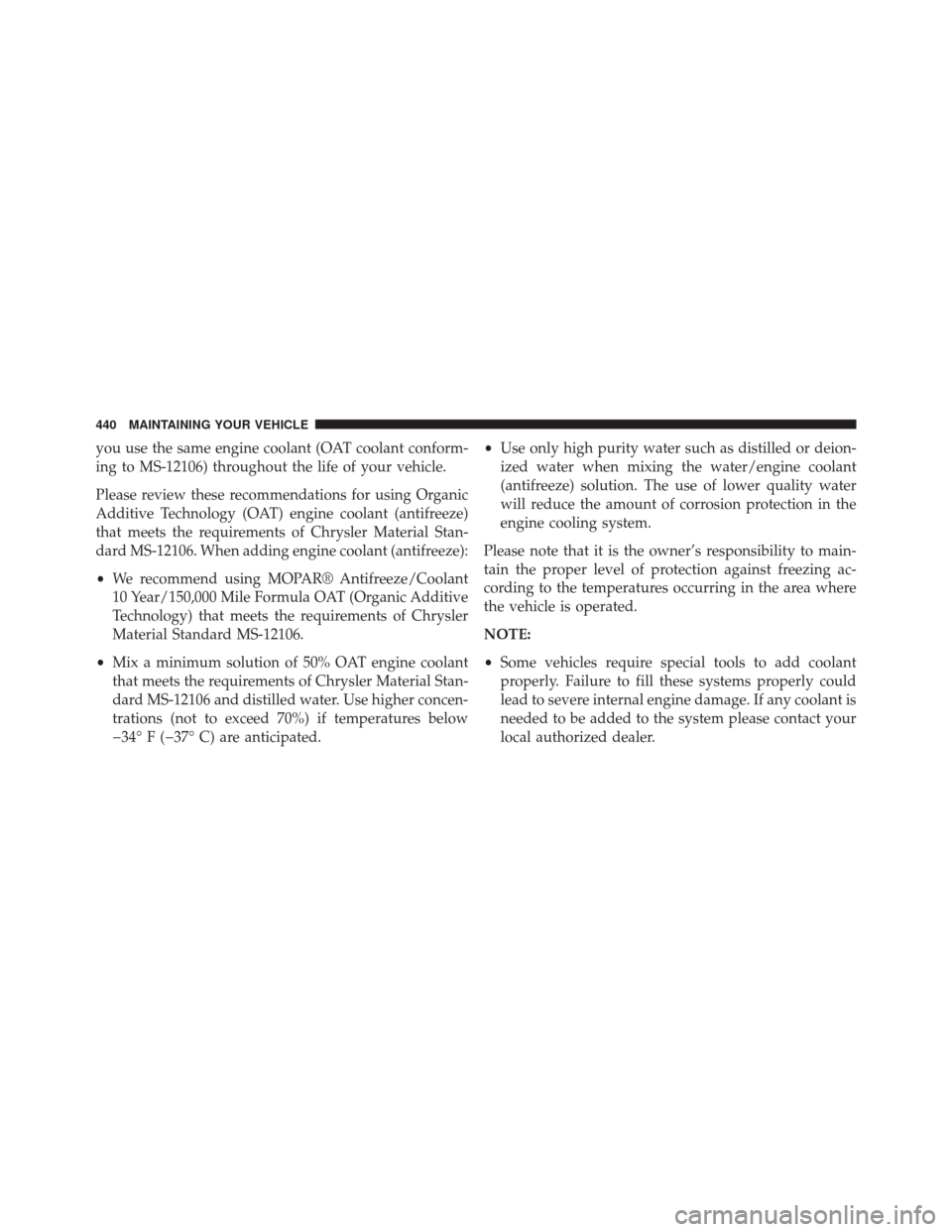
you use the same engine coolant (OAT coolant conform-
ing to MS-12106) throughout the life of your vehicle.
Please review these recommendations for using Organic
Additive Technology (OAT) engine coolant (antifreeze)
that meets the requirements of Chrysler Material Stan-
dard MS-12106. When adding engine coolant (antifreeze):
•We recommend using MOPAR® Antifreeze/Coolant
10 Year/150,000 Mile Formula OAT (Organic Additive
Technology) that meets the requirements of Chrysler
Material Standard MS-12106.
• Mix a minimum solution of 50% OAT engine coolant
that meets the requirements of Chrysler Material Stan-
dard MS-12106 and distilled water. Use higher concen-
trations (not to exceed 70%) if temperatures below
�34° F (�37° C) are anticipated. •
Use only high purity water such as distilled or deion-
ized water when mixing the water/engine coolant
(antifreeze) solution. The use of lower quality water
will reduce the amount of corrosion protection in the
engine cooling system.
Please note that it is the owner’s responsibility to main-
tain the proper level of protection against freezing ac-
cording to the temperatures occurring in the area where
the vehicle is operated.
NOTE:
• Some vehicles require special tools to add coolant
properly. Failure to fill these systems properly could
lead to severe internal engine damage. If any coolant is
needed to be added to the system please contact your
local authorized dealer.
440 MAINTAINING YOUR VEHICLE
Page 443 of 529
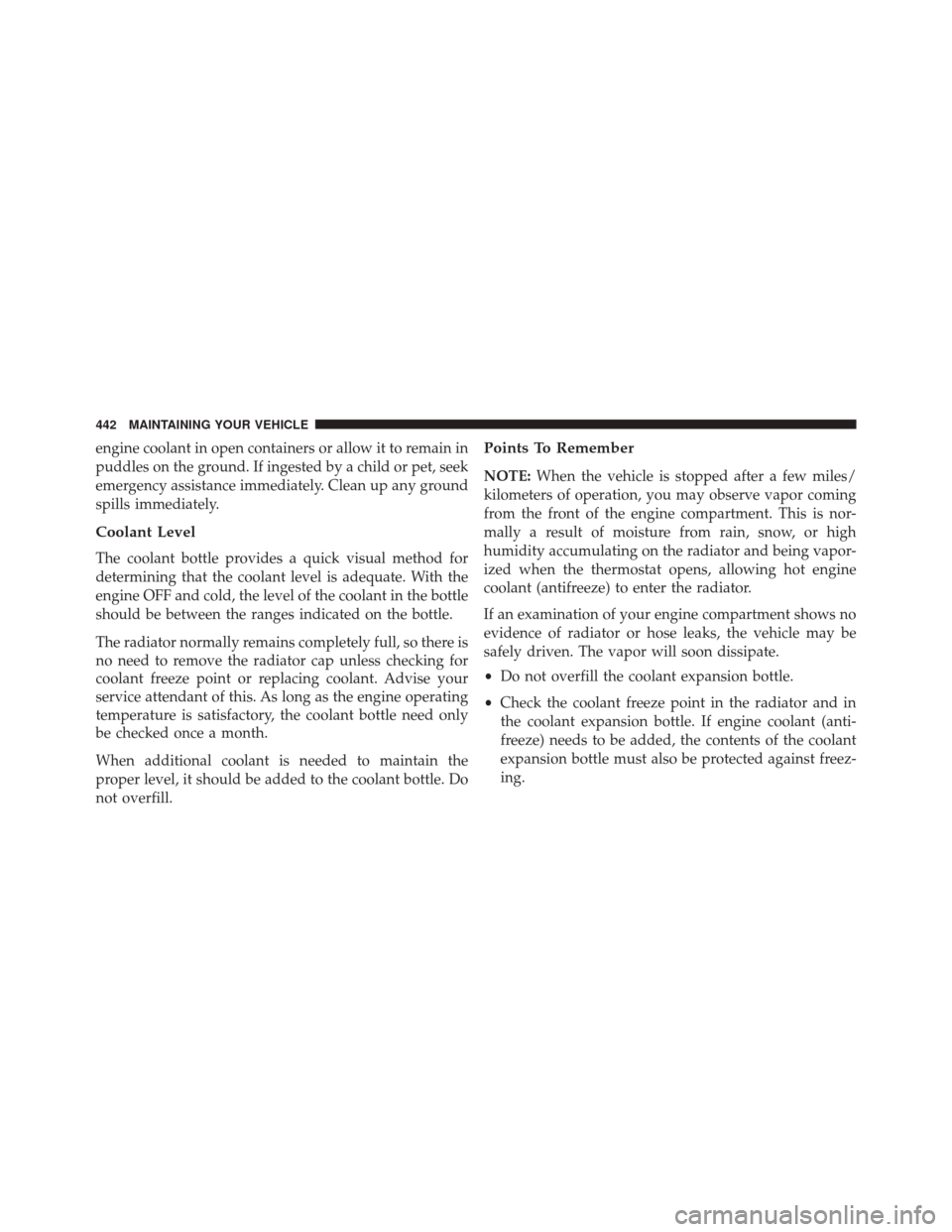
engine coolant in open containers or allow it to remain in
puddles on the ground. If ingested by a child or pet, seek
emergency assistance immediately. Clean up any ground
spills immediately.
Coolant Level
The coolant bottle provides a quick visual method for
determining that the coolant level is adequate. With the
engine OFF and cold, the level of the coolant in the bottle
should be between the ranges indicated on the bottle.
The radiator normally remains completely full, so there is
no need to remove the radiator cap unless checking for
coolant freeze point or replacing coolant. Advise your
service attendant of this. As long as the engine operating
temperature is satisfactory, the coolant bottle need only
be checked once a month.
When additional coolant is needed to maintain the
proper level, it should be added to the coolant bottle. Do
not overfill.
Points To Remember
NOTE:When the vehicle is stopped after a few miles/
kilometers of operation, you may observe vapor coming
from the front of the engine compartment. This is nor-
mally a result of moisture from rain, snow, or high
humidity accumulating on the radiator and being vapor-
ized when the thermostat opens, allowing hot engine
coolant (antifreeze) to enter the radiator.
If an examination of your engine compartment shows no
evidence of radiator or hose leaks, the vehicle may be
safely driven. The vapor will soon dissipate.
• Do not overfill the coolant expansion bottle.
• Check the coolant freeze point in the radiator and in
the coolant expansion bottle. If engine coolant (anti-
freeze) needs to be added, the contents of the coolant
expansion bottle must also be protected against freez-
ing.
442 MAINTAINING YOUR VEHICLE
Page 472 of 529
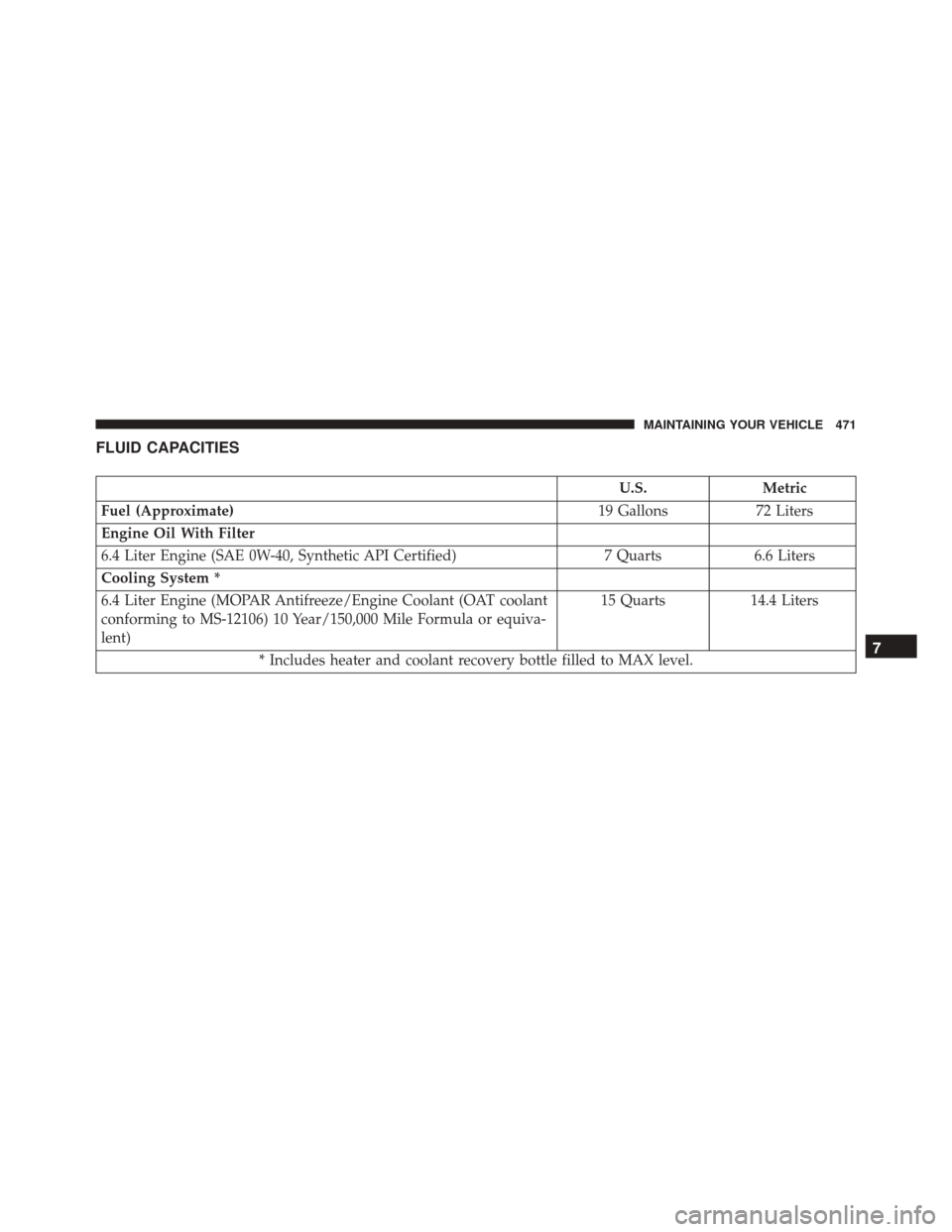
FLUID CAPACITIES
U.S.Metric
Fuel (Approximate) 19 Gallons72 Liters
Engine Oil With Filter
6.4 Liter Engine (SAE 0W-40, Synthetic API Certified) 7 Quarts6.6 Liters
Cooling System *
6.4 Liter Engine (MOPAR Antifreeze/Engine Coolant (OAT coolant
conforming to MS-12106) 10 Year/150,000 Mile Formula or equiva-
lent) 15 Quarts
14.4 Liters
* Includes heater and coolant recovery bottle filled to MAX level.
7
MAINTAINING YOUR VEHICLE 471
Page 478 of 529
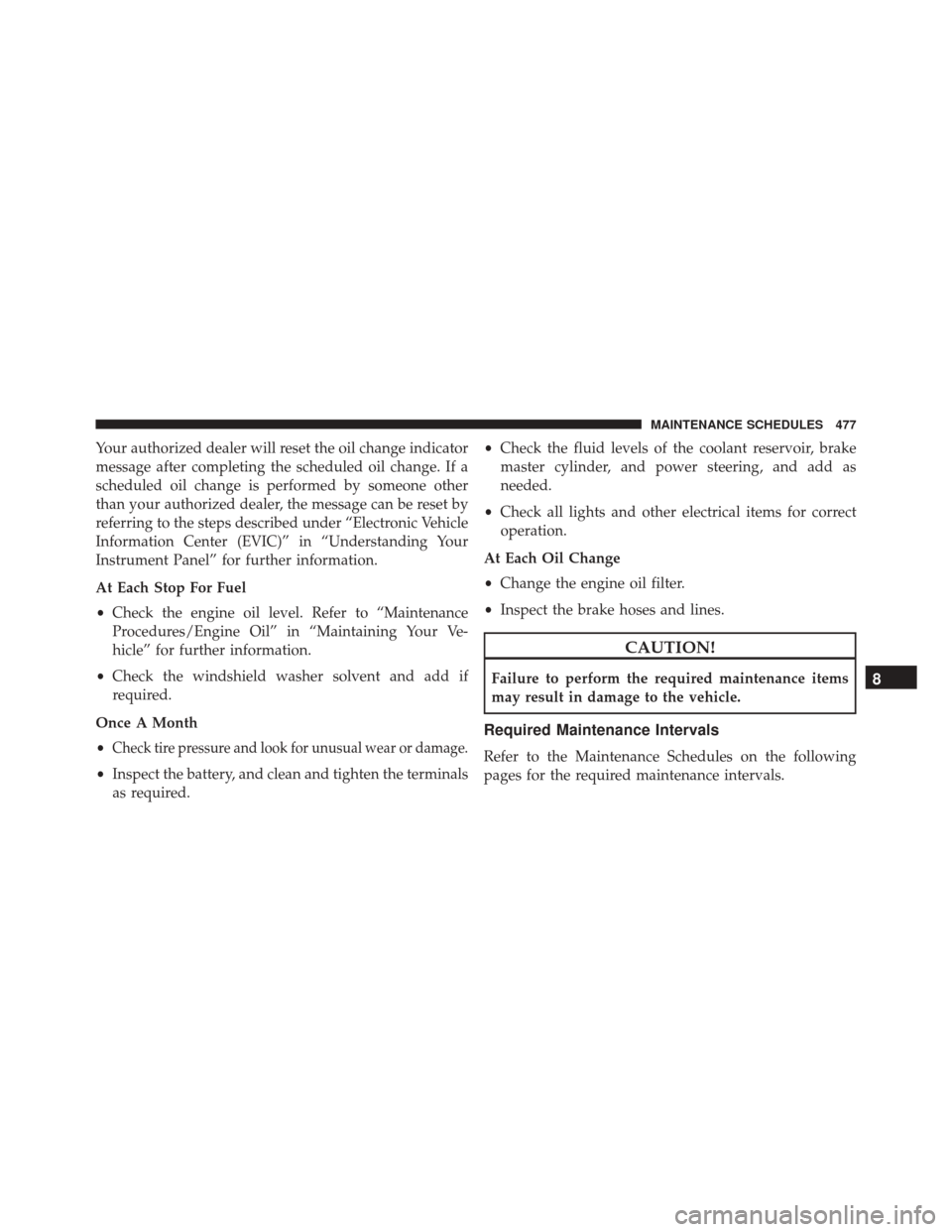
Your authorized dealer will reset the oil change indicator
message after completing the scheduled oil change. If a
scheduled oil change is performed by someone other
than your authorized dealer, the message can be reset by
referring to the steps described under “Electronic Vehicle
Information Center (EVIC)” in “Understanding Your
Instrument Panel” for further information.
At Each Stop For Fuel
•Check the engine oil level. Refer to “Maintenance
Procedures/Engine Oil” in “Maintaining Your Ve-
hicle” for further information.
• Check the windshield washer solvent and add if
required.
Once A Month
•
Check tire pressure and look for unusual wear or damage.
• Inspect the battery, and clean and tighten the terminals
as required. •
Check the fluid levels of the coolant reservoir, brake
master cylinder, and power steering, and add as
needed.
• Check all lights and other electrical items for correct
operation.
At Each Oil Change
• Change the engine oil filter.
• Inspect the brake hoses and lines.
CAUTION!
Failure to perform the required maintenance items
may result in damage to the vehicle.
Required Maintenance Intervals
Refer to the Maintenance Schedules on the following
pages for the required maintenance intervals.
8
MAINTENANCE SCHEDULES 477
Page 510 of 529
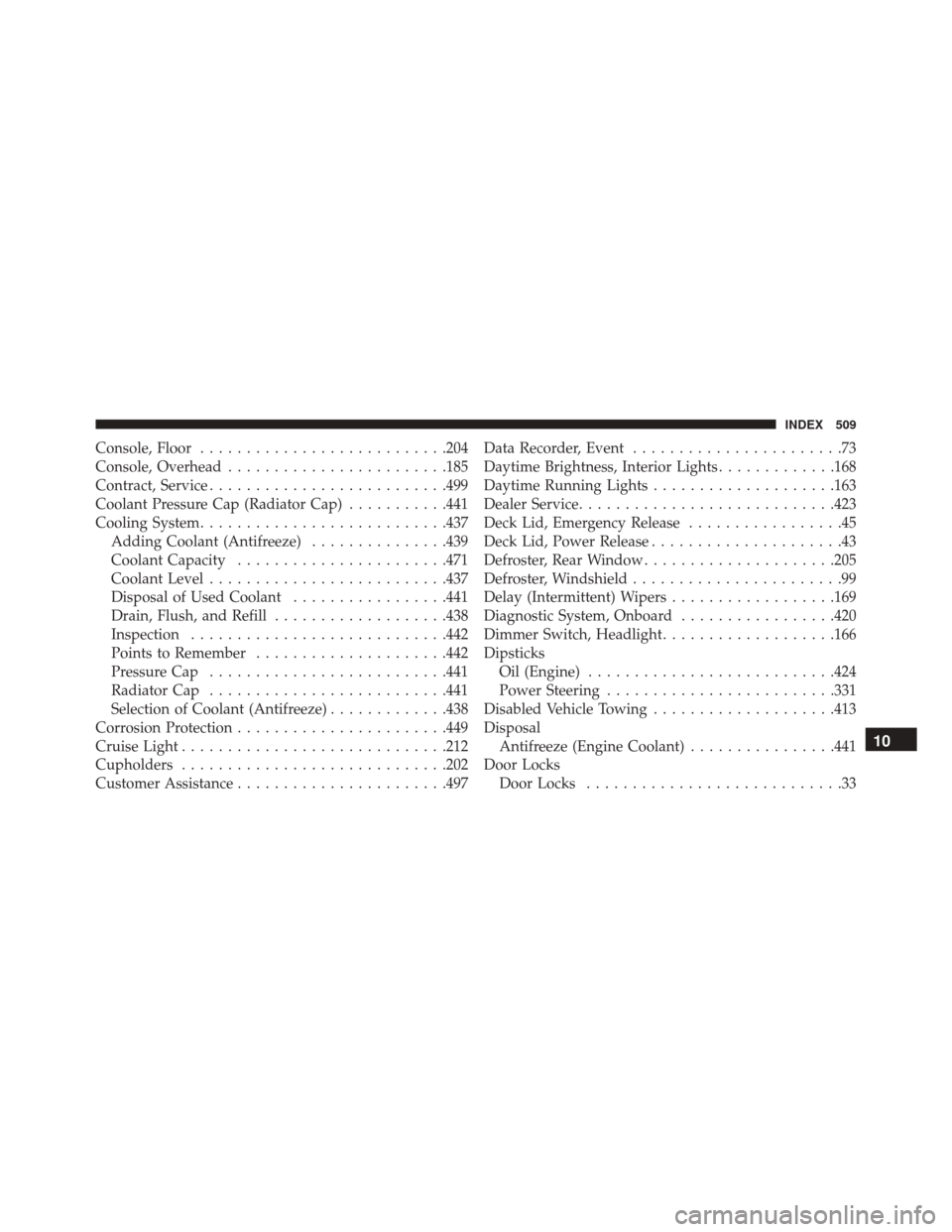
Console, Floor.......................... .204
Console, Overhead ....................... .185
Contract, Service ......................... .499
Coolant Pressure Cap (Radiator Cap) ...........441
Cooling System .......................... .437
Adding Coolant (Antifreeze) ...............439
Coolant Capacity ...................... .471
Coolant Level ......................... .437
Disposal of Used Coolant .................441
Drain, Flush, and Refill ...................438
Inspection ........................... .442
Points to Remember .....................442
Pressure Cap ......................... .441
Radiator Cap ......................... .441
Selection of Coolant (Antifreeze) .............438
Corrosion Protection ...................... .449
Cruise Light ............................ .212
Cupholders ............................ .202
Customer Assistance ...................... .497Data Recorder, Event
.......................73
Daytime Brightness, Interior Lights .............168
Daytime Running Lights ....................163
Dealer Service ........................... .423
Deck Lid, Emergency Release .................45
Deck Lid, Power Release .....................43
Defroster, Rear Window .....................205
Defroster, Windshield .......................99
Delay (Intermittent) Wipers ..................169
Diagnostic System, Onboard .................420
Dimmer Switch, Headlight ...................166
Dipsticks Oil (Engine) .......................... .424
Power Steering ........................ .331
Disabled Vehicle Towing ....................413
Disposal Antifreeze (Engine Coolant) ................441
Door Locks Door Locks ............................
33
10
INDEX 509
Page 511 of 529
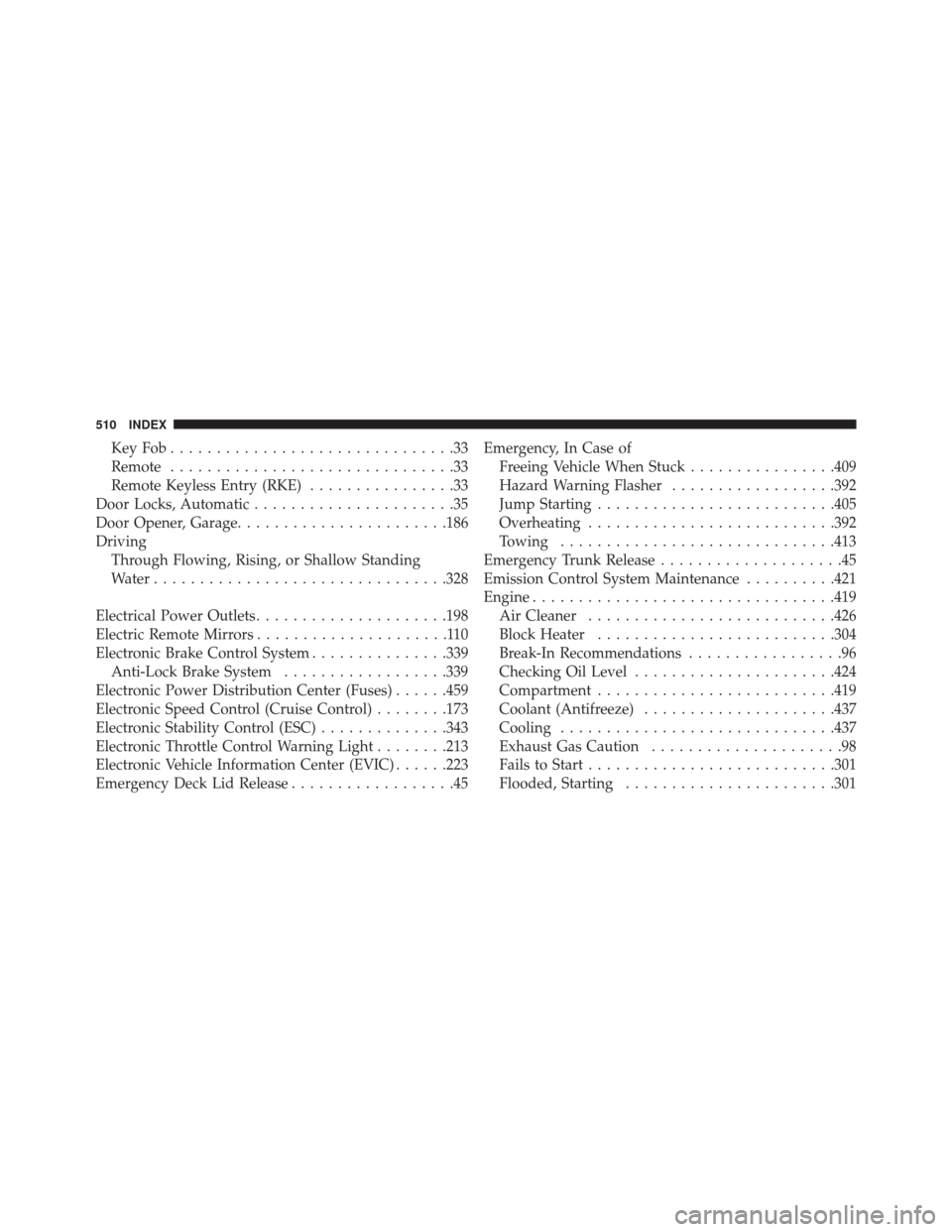
KeyFob...............................33
Remote...............................33
Remote Keyless Entry (RKE) ................33
Door Locks, Automatic ......................35
Door Opener, Garage ...................... .186
Driving Through Flowing, Rising, or Shallow Standing
Water ............................... .328
Electrical Power Outlets .....................198
Electric Remote Mirrors .....................110
Electronic Brake Control System ...............339
Anti-Lock Brake System ..................339
Electronic Power Distribution Center (Fuses) ......459
Electronic Speed Control (Cruise Control) ........173
Electronic Stability Control (ESC) ..............343
Electronic Throttle Control Warning Light ........213
Electronic Vehicle Information Center (EVIC) ......223
Emergency Deck Lid Release ..................45Emergency, In Case of
Freeing Vehicle When Stuck ................409
Hazard Warning Flasher ..................392
Jump Starting ......................... .405
Overheating .......................... .392
Towing ............................. .413
Emergency Trunk Release ....................45
Emission Control System Maintenance ..........421
Engine ................................ .419
Air Cleaner .......................... .426
Block Heater ......................... .304
Break-In Recommendations .................96
Checking Oil Level ..................... .424
Compartment ......................... .419
Coolant (Antifreeze) .....................437
Cooling ............................. .437
Exhaust Gas Caution .....................98
Fails to Start .......................... .301
Flooded, Starting ...................... .301
510 INDEX